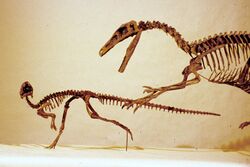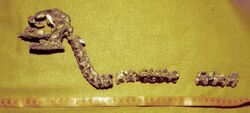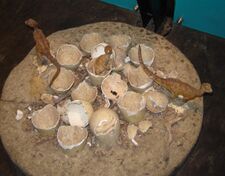Biology:Orodromeus
| Orodromeus | |
|---|---|

| |
| Orodromeus makelai | |
| Scientific classification | |
| Domain: | Eukaryota |
| Kingdom: | Animalia |
| Phylum: | Chordata |
| Clade: | Dinosauria |
| Clade: | †Ornithischia |
| Family: | †Thescelosauridae |
| Subfamily: | †Orodrominae |
| Genus: | †Orodromeus Horner & Weishampel, 1988 |
| Species: | †O. makelai
|
| Binomial name | |
| †Orodromeus makelai Horner & Weishampel, 1988
| |
Orodromeus (meaning "Mountain Runner") is a genus of herbivorous orodromine thescelosaurid dinosaur from the Late Cretaceous of North America. Only one species is known, the type species Orodromeus makelai.
Discovery and naming
The remains of Orodromeus were discovered by Robert Makela during the excavation in Teton County, Montana, of the Egg Mountain brooding colony of a much larger relative, Maiasaura. The type species, Orodromeus makelai, was named and shortly described by Jack Horner and David B. Weishampel in 1988. The generic name is derived from Greek ὄρος, oros, "mountain", in reference to the Egg Mountain site, and δρομεύς, dromeus, "runner", referring to the cursorial habits of the animal. The specific name honoured the late Makela.[1]
The holotype specimen, MOR 294, was found in a layer of the Two Medicine Formation, dating from the Campanian stage, about 75 million years ago. It consists of a partial skeleton with skull. The paratypes are MOR 246, a clutch of nineteen eggs, some with embryos; PP 22412, a set of hindlimbs; MOR 331, a partial skeleton; MOR 248, a skeleton with skull; and MOR 403, a braincase.[1] A full published description is still lacking, though an unpublished thesis on Orodromeus exists.[2] However, MOR 246 and other eggs from Egg Mountain are now considered to belong to a troodontid[3] which may be Stenonychosaurus.[4]
Description
Orodromeus was a small fast bipedal herbivore that probably coexisted with dinosaurs such as Daspletosaurus and Einiosaurus. Its length was estimated by Horner & Weishampel at 2.5 metres.[1]
Orodromeus is distinguished by a palpebral that is at its back attached to the postorbital; a boss on the jugal; a non-fused wrist; quill knobs on the ulna on one juvenile specimen; and triangular maxillary and dentary teeth with a superficial flat occlusion.[1]
Phylogeny
Orodromeus was by Horner & Weishampel assigned to the Hypsilophodontidae, as the youngest known member.[1] Today these are seen as an unnatural, paraphyletic, group, and Orodromeus is simply considered to be a basal member of the Euornithopoda. Brown et al. (2013[5]) put it in the family Thescelosauridae and named a new subfamily (Orodrominae) after it.
Palaeobiology
Because of the advanced development of the bones and teeth of the embryos, Horner concluded that the young of Orodromeus were precocial.
It has been speculated that this animal may have burrowed much like its relative Oryctodromeus, based upon the packing of their bones in situations where they typically would have been scattered.[6]
Mallon et al. (2013) examined herbivore coexistence on the island continent of Laramidia, during the Late Cretaceous. It was concluded that small ornithischians like Orodromeus were generally restricted to feeding on vegetation at, or below the height of 1 meter.[7]
References
- ↑ 1.0 1.1 1.2 1.3 1.4 Horner, J. and Weishampel, D., 1988, "A comparative embryological study of two ornithischian dinosaurs", Nature (London), 332(No. 6161): 256-257 (1988)
- ↑ Scheetz, R.D., 1999, Osteology of Orodromeus makelai and the phylogeny of basal ornithopod dinosaurs D. Ph. Thesis in Biology, Montana State University, Bozeman, 189 pp
- ↑ Varricchio, D.J.; Jackson, F.; Borkowski, J.J.; Horner, J.R. (1997). "Nest and egg clutches of the dinosaur Troodon formosus and the evolution of avian reproductive traits". Nature 385 (6613): 247–250. doi:10.1038/385247a0. Bibcode: 1997Natur.385..247V.
- ↑ van der Reest, A. J.; Currie, P. J. (2017). "Troodontids (Theropoda) from the Dinosaur Park Formation, Alberta, with a description of a unique new taxon: implications for deinonychosaur diversity in North America". Canadian Journal of Earth Sciences 54 (9): 919–935. doi:10.1139/cjes-2017-0031. Bibcode: 2017CaJES..54..919V.
- ↑ Brown (2013). "New data on the diversity and abundance of small-bodied ornithopods (Dinosauria, Ornithischia) from the Belly River Group (Campanian) of Alberta". Journal of Vertebrate Paleontology 33 (3): 495–520. doi:10.1080/02724634.2013.746229.
- ↑ Varricchio, David J.; Martin, Anthony J.; Katsura, Yoshihiro (2007). "First trace and body fossil evidence of a burrowing, denning dinosaur". Proceedings of the Royal Society B: Biological Sciences 274 (1616): 1361–1368. doi:10.1098/rspb.2006.0443. PMID 17374596.
- ↑ Mallon, Jordan C; David C Evans; Michael J Ryan; Jason S Anderson (2013). "Feeding height stratification among the herbivorous dinosaurs from the Dinosaur Park Formation (upper Campanian) of Alberta, Canada". BMC Ecology 13: 14. doi:10.1186/1472-6785-13-14. PMID 23557203.
Wikidata ☰ Q134226 entry
 |






